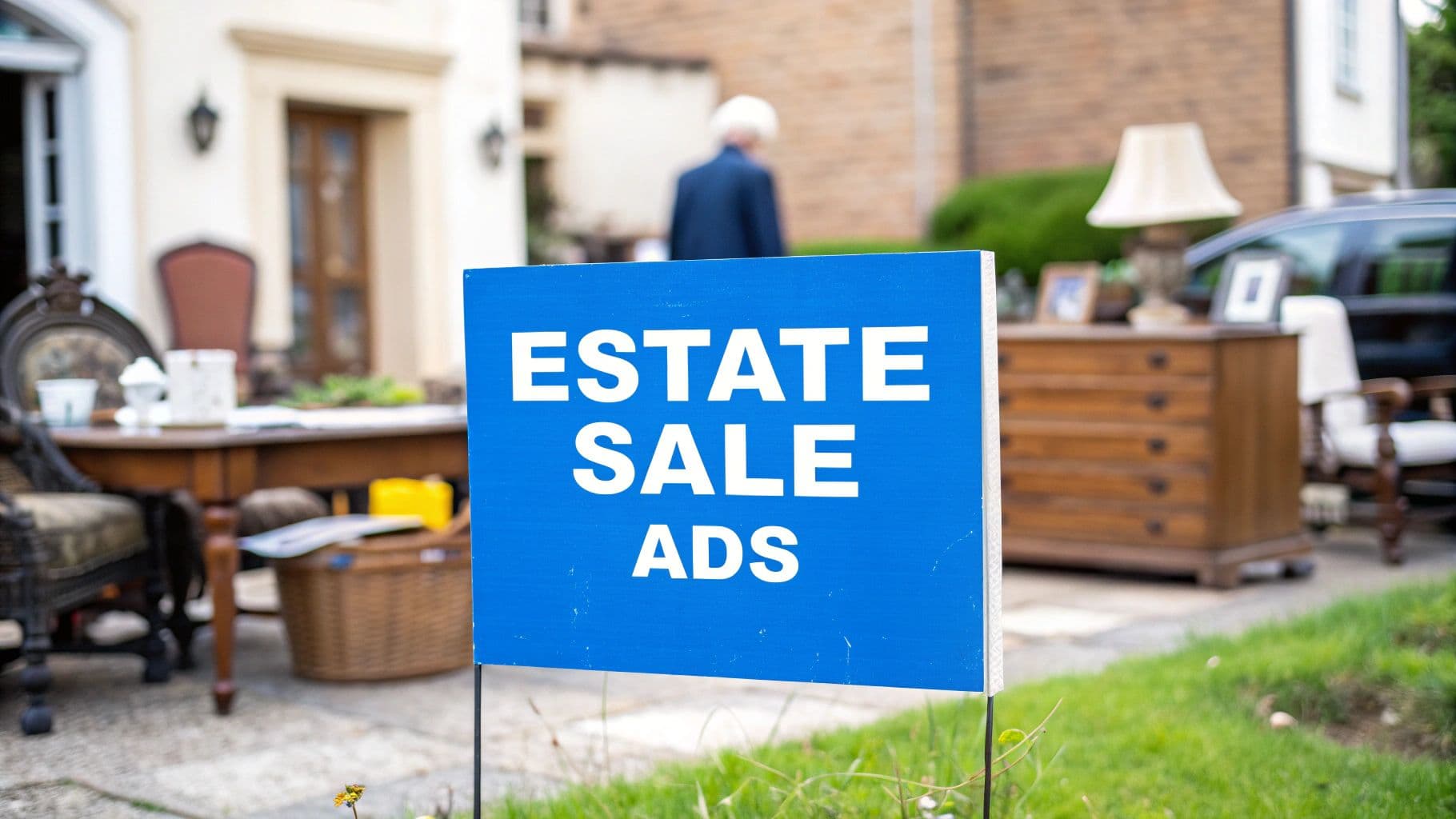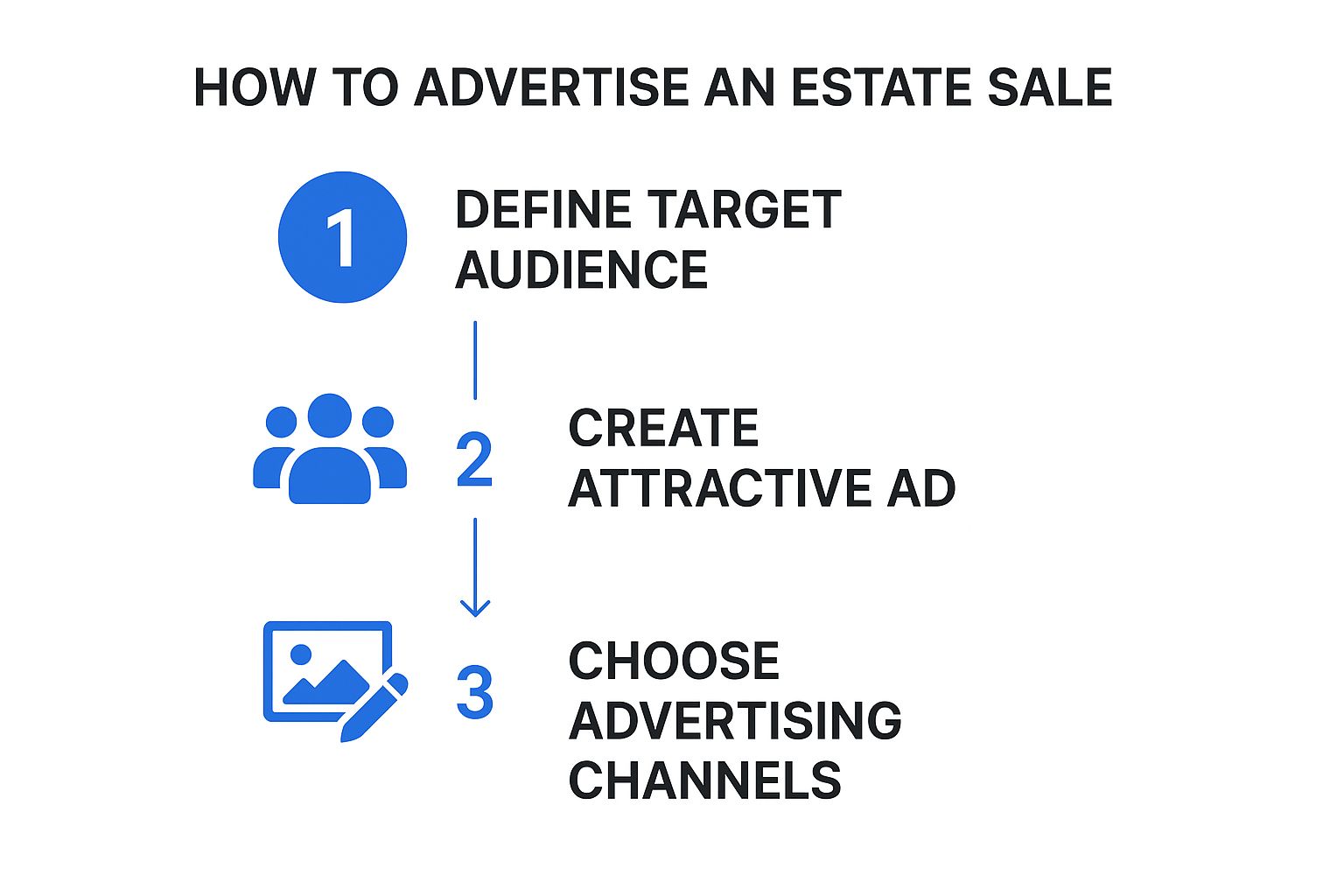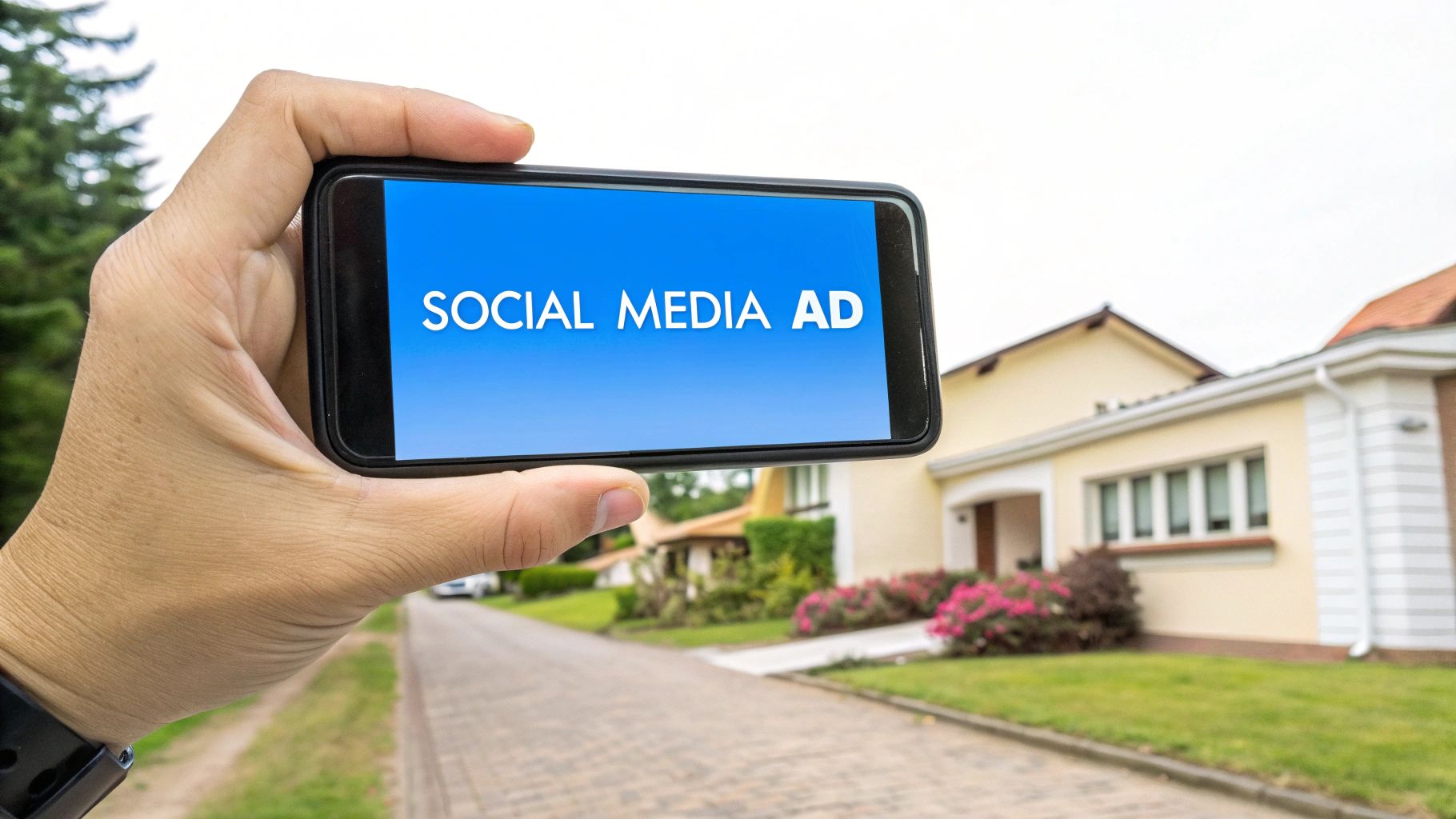How to Advertise an Estate Sale for Maximum Profit

Before you even think about placing an ad, you need to gather your ammunition. The success of your estate sale advertising completely depends on the quality of your raw materials: great photos, detailed descriptions, and a firm schedule. Get this right, and the marketing part becomes a whole lot easier.
Building Your Pre-Sale Advertising Foundation
The real work of promoting an estate sale starts long before the first ad ever goes live. This prep phase isn't about shouting from the rooftops; it’s about creating compelling, high-quality content that will grab the attention of serious buyers. Think of it this way: you can't build a great house on a shaky foundation.
Your first job is to build a detailed inventory. Walk through every room and make a list of the standout items. We're talking furniture, antiques, collectibles, art, and anything with a recognizable brand name. This list is the core of your ad copy.
Photograph Everything That Matters
Let's be blunt: your photos are your most powerful marketing tool. They're the first thing shoppers see, and bad pictures will kill interest before it even starts. You don't need to be a professional photographer, but you do need to put in some effort.
- Let the Sun In: Always use natural light. Stage items near a window to avoid weird shadows and the yellow glow from indoor bulbs.
- Clear the Clutter: A messy background is distracting. Find a neutral wall or toss a simple sheet behind the item to make it pop.
- Show Every Side: Take photos of the front, back, and any interesting details. If there's a flaw, show it. Honesty builds trust with buyers.
- Zoom in on the Good Stuff: Get close-ups of brand labels, artist signatures, or unique details. This is what tells a buyer an item is special.

Research and Price with Confidence
Pricing is a tightrope walk. Go too high, and you'll scare people off. Go too low, and you're leaving money on the table. The goal is to find the fair market value—not what you think something is worth, but what someone is actually willing to pay for it right now.
To find that sweet spot, you need to do a little homework. Hop on sites like eBay and look at the "sold" listings, not the active ones. Check Facebook Marketplace and specialized sites like EstateSales.org to see what similar items have recently sold for. This research makes your pricing realistic and competitive, which is a huge magnet for experienced shoppers.
Estate Sale Advertising Channel Planner
To help you decide where to focus your energy, here’s a quick breakdown of the most common advertising channels. Each one reaches a different type of buyer, so a good marketing plan often uses a mix of them.
| Channel Type | Primary Audience | Best Use Case |
|---|---|---|
| Online Listing Sites | Dedicated estate sale shoppers, collectors | The core of your campaign; best for detailed listings and photos. |
| Social Media (Facebook) | Local community, niche collector groups | Great for generating buzz and sharing key items with targeted groups. |
| Local Online Classifieds | Bargain hunters, local general shoppers | Good for broader reach and attracting casual weekend shoppers. |
| Physical Signage | Drive-by traffic, neighbors | Essential for guiding people to the sale on the actual days. |
| Email Newsletters | Repeat customers, loyal followers | Perfect if you have an existing list of interested buyers. |
Think of this table as your strategic guide. You wouldn't use a hammer to saw a board, and you shouldn't use physical signs to reach online collectors. Matching the channel to the audience is the key to getting the right people to your sale.
Mastering Digital Channels for Your Estate Sale
If you want a profitable estate sale, a strong online presence isn't just nice to have—it's everything. Knowing where and how to advertise your sale online is what gets you in front of the widest possible audience, from local bargain hunters to serious collectors who will drive for hours for the right find.

This all starts with specialized online listing platforms. These sites are where the real estate sale shoppers live and breathe. Think of them as the digital town square for anyone hunting for deals, antiques, and unique household goods.
Create Listings That Command Attention
Your listing is your digital storefront, so it needs to do more than just exist. You have to craft a compelling story that gives the sale some personality. Was the previous owner a passionate collector of mid-century modern furniture? A world traveler who brought back unique art? Mentioning these details adds character and hooks buyers searching for specific styles.
When you sit down to write, focus on clarity and detail:
- Lead With Your Best Stuff: Put your most valuable or interesting items right at the top. This means in the first few photos and at the beginning of your description. It’s your hook.
- Be Specific: Don't just say "brown chair." Instead, write "Vintage 1960s Henredon leather club chair with original upholstery." Always include dimensions and be honest about any wear and tear.
- Keep It Organized: Group your photos and descriptions by room (e.g., "Kitchen & Dining," "Garage & Tools"). This makes it incredibly easy for shoppers to scan and find what they’re looking for.
A well-crafted listing does more than announce a sale; it creates a sense of discovery. By telling a story and highlighting what makes the collection special, you turn a simple sale into an event people feel they can't afford to miss.
Harness the Power of Video Walkthroughs
Photos are a must, but a video walkthrough is your secret weapon. A quick, one-to-two-minute video tour gives potential buyers a real feel for the home's layout and just how much stuff is available. It's a simple step that can dramatically boost interest.
The impact of video is undeniable. In the real estate world, for example, listings with video get up to 403% more inquiries, and 73% of homeowners say they'd rather list with agents who use it. Video can also boost a buyer's confidence by 28%—a huge deal when you're asking people to invest their time and money.
Making one is easy. Just walk through the house with your smartphone, panning slowly across rooms and zooming in on some of the standout items. You don't need fancy editing skills—a steady hand and decent light are all it takes.
Leverage Social Media and Local Groups
Beyond the dedicated estate sale sites, social media is a free and powerful way to spread the word. For reaching thousands of potential buyers in your immediate area, Facebook Marketplace and local community groups are absolute goldmines.
To get the most out of it:
- Post Strategically: Share your ad in relevant local buy/sell/trade groups, neighborhood pages, and any niche groups that fit the items (like "Vintage Pyrex Collectors of Ohio," for instance).
- Time It Right: Put up your first announcement one to two weeks before the sale. Then, post reminders a few days before and on the morning of the sale to catch those last-minute shoppers.
- Engage With Comments: Be ready to answer questions about pricing, dimensions, or availability. Responding quickly and politely builds trust and keeps your post visible in the group’s feed.
By mastering these digital channels, you’ll create a powerful online footprint that makes your sale impossible to ignore. Our comprehensive guide on https://www.diyauctions.com/learn/estate-sale-advertising can give you even more ideas to round out your promotional plan.
Winning with Traditional and Local Advertising
While your online promotion is busy reaching people across the web, you can't forget about the power of old-school local advertising. Honestly, these on-the-ground methods are what drive a ton of foot traffic from neighbors, curious passersby, and folks in the community who might never see your Facebook post.
A great promotion strategy is a blend of both worlds—digital and traditional—making sure your sale is impossible to miss.

This hybrid approach isn't new; it has deep roots in what's called out-of-home (OOH) advertising, and it’s more relevant than ever. The global OOH market was valued at $20.1 billion and is expected to nearly double to $40.3 billion by 2032. That’s a clear sign that physical ads still grab serious attention. This growth is all about hyperlocal campaigns that connect with local communities—a perfect model for an estate sale. For a deeper dive, you can explore the full research on the out-of-home advertising market.
Maximize Visibility with Smart Signage
On the days of your sale, directional signs are your absolute best friend. Their job is simple: get interested buyers to your front door. But there’s a right way and a wrong way to do it.
- Be Bold and Simple: Grab a thick black marker and some brightly colored poster board—think neon yellow or hot pink. Write "ESTATE SALE" in giant letters with a clear, unmissable arrow pointing the way.
- Place Them Strategically: Start at the closest major intersection and work your way in. Place a sign at every single turn someone would need to make to find the house. Put yourself in the shoes of a driver who has never been to your neighborhood.
- Check Local Rules: This is a big one. Before you put up a single sign, do a quick check on your city or HOA's rules for temporary signage. The last thing you want is for a city worker to pull them all down halfway through the first day.
Leverage Community Hubs with Flyers
Flyers are a fantastic, low-cost way to get the word out to people where they already spend their time. Create a clean, one-page flyer with the essential info: dates, address, hours, and a few tempting photos of your best items.
Be specific! Mentioning "mid-century furniture" or a "vintage tool collection" is much more effective than generic language and will pull in buyers looking for exactly what you have.
A well-placed flyer in a busy local spot becomes your silent salesperson. It turns someone's daily coffee run or grocery trip into a potential visit to your sale.
Some of the best places to post flyers include:
- Community bulletin boards in local libraries and grocery stores.
- Countertops at nearby coffee shops and diners (always ask for permission first!).
- Lobbies of community centers or local gyms.
If the estate has truly valuable or specialized collections, like fine art or rare antiques, placing a small ad in the local newspaper or a niche publication can still be a smart move. These channels often reach a dedicated, older demographic of serious collectors who aren't scrolling through social media.
Remember, every item has a potential buyer. If you need a hand figuring out what your things are worth, our guide on how to price estate sale items is the perfect place to start.
Connecting with Niche Buyers and Collector Networks
General advertising is great for getting foot traffic, but the real money often comes from targeted outreach. To really knock a sale out of the park, you have to go beyond broad announcements and connect directly with the collectors and die-hard enthusiasts who see the true value in your specialized items.
This is how you turn a single piece of rare pottery or a vintage watch into a bidding war. It's all about understanding what an item is worth from a collector's point of view—what we call fair market value. For them, it’s not just a cool old thing; it’s the missing piece of a set, a work by a specific artist, or a pristine example of something they are truly passionate about. Your marketing needs to speak their language.
Find and Engage with Collector Communities
Serious collectors don’t just stumble upon sales. They live and breathe their hobbies in dedicated communities, constantly discussing, trading, and hunting for their next big find. Your mission is to find these digital hangouts.
Start by searching for online forums and groups related to the unique items in the estate. A quick search for "antique military collectibles forum" or "mid-century modern furniture collectors group" will almost always lead you to a thriving community. Social media is another goldmine for these groups.
- Facebook Groups: Look for groups focused on specific brands, eras, or types of items. Think "Vintage Pyrex Collectors" or "Antique Book Enthusiasts."
- Reddit: Subreddits like r/antiques or r/Mid_Century are fantastic starting points. Drill down to find even more specific subreddits that match what you're selling.
- Specialized Forums: Don't sleep on old-school forums. Websites dedicated to niche interests like vintage audio gear or classic cameras often have "for sale" sections or allow posts about relevant local sales.
When you post, don't just drop a link and run. That feels like spam. Instead, share high-quality photos of the specific items you know that group will love. Mention you're getting ready for an estate sale. This simple courtesy builds trust and gets people genuinely excited.
Craft Targeted Emails and Personal Outreach
If the estate includes a known collection, or if you've run sales before and have a list of past buyers, an email list is your secret weapon. A personal, well-crafted email can spark major interest from a highly qualified audience before the sale even begins.
A well-timed email to a targeted list isn't just an announcement; it's a VIP invitation. You're giving your most dedicated followers the first look, creating a sense of exclusivity and urgency that drives them to show up early and ready to buy.
If you can, segment your list. Sent an email featuring the gorgeous dining set to people who have bought furniture before. For the art lovers, create a separate email showcasing the available paintings and prints.
In your message, be sure to tease the best items with fantastic photos, but don't reveal the prices. It's a classic estate sale strategy for a reason. It creates intrigue and encourages serious buyers to show up in person to learn more. This direct line to people who are ready to spend is often what separates a decent sale from a spectacularly profitable one.
Managing Your Sale Days for a Smooth Execution
Once your ads are out there, the game changes. You pivot from promotion to execution. Getting people to show up is one thing, but running a smooth, profitable sale is where the real work—and success—lies. All that advertising effort comes down to how well you handle the sale days themselves.

The final push happens in the days right before you open the doors. This is when you deploy your last-minute, high-visibility advertising. While your online listings have been drumming up interest for weeks, the last 48 hours are all about creating local buzz and making sure people can find you.
Deploying Your Day-Of Advertising
Your final advertising push is all about on-the-ground tactics. You’re not trying to find a brand new audience anymore; you’re activating the interest you’ve already built.
- Directional Signs: Get these up the night before or the morning of the sale. Start at the nearest major intersection and place a sign at every single turn someone would need to make to get to the house. Make it impossible to get lost.
- Final Social Media Blast: Post a "Sale Starts Tomorrow!" or "We're Open!" announcement on Facebook Marketplace and any local groups you’ve joined. I like to save a few photos of really desirable items for this post to create a little last-minute frenzy.
- Email Reminder: If you're building an email list (and you should be!), send out a final "See you at the sale!" message. Make sure the hours and address are front and center.
Managing the Crowd and Checkout
A busy sale is a fantastic problem to have. But it can turn into pure chaos without a solid plan. Good organization is your best friend when the crowds start pouring in.
You might need to limit how many people are in the house at once, especially during that first-hour rush. A simple "one-in, one-out" policy once you reach a comfortable capacity is a lifesaver. It keeps the rooms from getting dangerously crowded and helps prevent items from getting knocked over and broken.
A streamlined checkout is non-negotiable. It's the final impression you leave with a buyer. A slow, disorganized process can sour an otherwise great experience, while an efficient one makes shoppers feel valued and encourages them to come back for future sales.
Set up one clear checkout area, usually right near the exit. If you can, have at least two people working it. One person can add up the items and take payment, while the other wraps or bags the purchases. Trust me, this simple division of labor can cut your checkout line in half.
This whole process—from digital ads to managing the physical sale—is part of a much bigger trend. The real estate advertising market, already valued at $54.21 billion, is exploding. Property owners and professionals are ditching print for online platforms where they can target specific buyers with incredible precision. With the market projected to hit $75.06 billion by 2030, getting comfortable with technology for both advertising and managing your sales is no longer optional. It's essential. You can dig deeper into the evolution of real estate advertising to see where things are headed.
Common Estate Sale Advertising Questions
When you start thinking about promoting your estate sale, a few key questions always pop up. Getting the answers right isn't just about ticking boxes; it's about building a solid plan, spending your money wisely, and feeling confident as you head toward sale day.
Let’s dig into the most common things people ask about timing, budgets, and when it might make sense to call in a professional.
How Far in Advance Should I Start Advertising?
The sweet spot for advertising is two to three weeks before your sale. This gives you enough time to build some serious buzz without the event getting lost in the shuffle of people's busy schedules.
I always recommend starting the clock by getting your big, detailed listings up on sites like EstateSales.net. Fill them with great photos and descriptions. This is also the perfect time to start teasing your best items in those niche Facebook groups for collectors or vintage lovers.
Then, you ramp things up as you get closer.
- The Final Week: This is your ground game. Start dropping flyers at local coffee shops, libraries, and community centers.
- 2-3 Days Before: Now's the time to run your local classified ads.
- The Day Before: Get all your directional street signs up. This is absolutely critical for catching that last-minute drive-by traffic.
This layered approach makes sure you capture everyone from the hardcore planners who map out their weekends weeks in advance to the spontaneous local shoppers who will make up a huge chunk of your crowd.
What Is a Realistic Advertising Budget?
You can do a lot with a little. A smart advertising budget for most estate sales lands somewhere between $100 and $500. Where you fall in that range really depends on the value of what you're selling and how competitive your local market is.
Don't think of this as a cost. It's an investment. A well-placed $50 ad can easily bring in hundreds, if not thousands, of extra dollars by attracting just one or two serious buyers who were perfect for your items.
A typical breakdown might look something like this:
- Premium Online Listings: $50 - $150
- Boosted Social Media Posts: $50 - $100
- Physical Signage & Flyers: $50 - $100
If the estate has high-value items—think fine art, rare antiques, or specialized collections—it’s wise to bump up that budget. This gives you the firepower for targeted ads in collector magazines or on hobbyist websites to reach the people who will pay top dollar. Knowing what your sale could earn helps put the ad spend in perspective; you can learn about the average estate sale proceeds in our detailed guide.
Should I Advertise Myself or Hire a Pro?
This really boils down to the classic trade-off: time versus money.
Going the DIY route means you get to keep the 30-50% commission that an estate sale company would typically take. If you have the time, you're comfortable with online tools, and the estate isn't overwhelmingly complex, advertising it yourself can be incredibly profitable.
But hiring a pro has some undeniable perks. They bring years of hands-on experience and, most importantly, a built-in email list and following of loyal, repeat customers. They take care of everything—pricing, staging, advertising, and managing the chaos of the sale itself.
If you're dealing with a massive estate, trying to manage things from another city, or have valuable items that are tough to price accurately, a professional is often the surest path to a stress-free and financially successful sale.